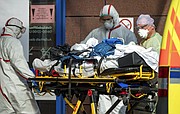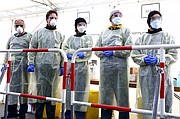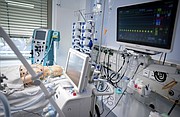Mass testing, empty ICUs: Germany scores early against virus
Frank Jordans | Hagadone News Network | UPDATED 5 years, 8 months AGO
BERLIN (AP) — Late last year — long before most people had heard of the new coronavirus now sweeping the globe — scientists in Germany sprang into action to develop a test for the virus that was causing an unusual respiratory disease in central China.
They had one by mid-January — and labs around the country were ready to start using it just weeks later, around the same time that Europe's most populous country registered its first case.
“It was clear that if the epidemic swept over here from China, then we had to start testing," said Hendrik Borucki, a spokesman for Bioscientia Healthcare, which operates 19 labs in Germany.
That quick work stands in stark contrast to delays and missteps in other countries. Coupled with Germany's large number of intensive care beds and its early social distancing measures, it could explain one of the most interesting puzzles of the COVID-19 pandemic: Why are people with the virus in Germany currently dying at much lower rates than in neighboring countries?
The numbers are remarkable: As confirmed cases in Germany passed 71,000, the death toll Wednesday was 775, according to a tally kept by Johns Hopkins University. In contrast, Italy has reported almost 106,000 infections and more than 12,400 deaths, while Spain has more than 102,000 cases with over 9,000 deaths.
France has four times as many virus deaths as Germany and Britain has twice as many, even though both countries have fewer reported infections.
There may be many factors at play, but experts said early on that fast and widespread testing gave Germany an edge.
“The reason why we in Germany have so few deaths at the moment compared to the number of infected can be largely explained by the fact that we are doing an extremely large number of lab diagnoses," said virologist Dr. Christian Drosten, whose team developed the first test for the new virus at Berlin's Charité hospital — established over 300 years ago to treat plague victims.
He estimated that Germany is now capable of conducting up to 500,000 tests a week.
Spain, meanwhile, tests between 105,000 and 140,000 people each week, about 20% to 30% what Germany is capable of. Italy did around 200,000 tests over the past week, but that reflects a significant recent ramp-up.
Early access to the test from Drosten's team is only part of the reason for Germany's head start. Before the country even registered its first case, authorities agreed the tests would be covered by its universal insurance system, and be available to everyone with symptoms and either recent travel to virus hotspots or close contact with a confirmed case.
Still, Germany may not be as much of an anomaly as it seems. The fact that Spain and Italy — which have seen much more intense outbreaks — are doing fewer tests indicates they are missing many mild or asymptomatic cases. That makes their fatality rates look worse than they are. But Germany, too, is likely missing cases, and experts say that all figures worldwide undercount the extent of the pandemic.
Limited testing also means the true spread of the virus is hidden in those countries — further fueling the outbreak.
For most people, the new coronavirus causes mild or moderate symptoms. But for some, especially older adults and people with existing health problems, it can cause more severe illness and lead to to death.
Ensuring those severely ill patients can be treated properly is key to managing the outbreak — and preventing deaths.
And there again, Germany has an advantage.
Italy had 8.6 intensive care unit beds per 100,000 people before the outbreak, according to the Organization for Cooperation and Economic Development. By comparison, Germany's most recent available figure is 33.9 per 100,000, or about 28,000 in total, a number the government wants to double.
“We are well prepared today, tomorrow and the day after tomorrow," said Dr. Uwe Janssens, who heads Germany's Interdisciplinary Association for Intensive Care and Emergency Medicine.
Hospitals in the hardest-hit areas of Italy, are now buckling under the weight of treating so many ill patients at once, contributing the country's death toll — the highest in the world.
In the rare position of having beds to spare, German hospitals have taken in dozens of patients from Italy and France. While that will allow German doctors and nurses to learn how to treat severely ill COVID-19 patients, it also reflects a remarkable confidence in the country's ability to manage its outbreak at a time when many others are shutting their borders.
The Robert Koch Institute, Germany's disease control center, has suggested that strong measures imposed almost three weeks ago, including closing schools and restaurants, and later barring more than two people from gathering outside, seem to have slowed the rate of new infections.
Experts have bemoaned that many countries took similar steps too late.
Scientists advising the British government say major social distancing measures are necessary before there are 0.2 deaths per 100,000 people. According to the, albeit imperfect, data available, Italy imposed its lockdown four days after hitting that threshold but Germany’s came a week before that level was reached.
Officials stress Germany is still in an early stage of its outbreak. But Dr. Sebastian Johnston, a professor of respiratory medicine at Imperial College London, said countries that intervene early with aggressive measures should theoretically be able to avoid the tsunami of cases seen in Italy and Spain.
“We were lucky to have had a long time to prepare,” said Dr. Susanne Herold, a specialist for lung infections at the university hospital in Giessen. For weeks, her staff has been installing new ICU beds, training in the use of ventilators and planning for an emergency scenario.
Amid the cautious optimism, there are those who warn against complacency.
Chancellor Angela Merkel — who is herself in isolation after her doctor tested positive — has resisted calls to loosen the lockdown. A top government medical adviser, Lothar Wieler of the Robert Koch Institute, said he wouldn't rule out Germany's health system reaching its limit, too.
“This is still the calm before the storm,” said Health Minister Jens Spahn.
___
Associated Press writers Nicole Winfield in Rome, Kirsten Grieshaber in Berlin and Maria Cheng in London contributed to this report.
___
Follow AP news coverage of the coronavirus pandemic at https://apnews.com/VirusOutbreak and https://apnews.com/UnderstandingtheOutbreak
ARTICLES BY FRANK JORDANS
Sidelined by rivals, Germany's far-right AfD bides time
BERLIN (AP) — Migration is a side issue in this year's German election campaign, but that hasn't stopped the country's biggest far-right party from trying to play it up.
Magnet milestones move distant nuclear fusion dream closer
SAINT-PAUL-LES-DURANCE, France (AP) — Teams working on two continents have marked similar milestones in their respective efforts to tap an energy source key to the fight against climate change: They’ve each produced very impressive magnets.
Magnet milestones move distant nuclear fusion dream closer
SAINT-PAUL-LES-DURANCE, France (AP) — Teams working on two continents have marked similar milestones in their respective efforts to tap an energy source key to the fight against climate change: They’ve each produced very impressive magnets.























